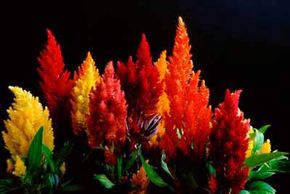The scientific name for plumed cockscomb, celosia, comes from the Greek word for "burned." These airy, feather duster look-alikes bear the vibrant colors that aptly fit the name. The exotic plumes make superb dried specimens, retaining their color long after harvest.
Advertisement
Description of plumed cockscomb: Shades ranging from electric reds, yellows, pinks, and oranges to more subtle, sand tones are available. Height ranges from 8 to 30 inches. Bloom lasts from June to October.
Growing plumed cockscomb: Full sun in average soil is recommended for celosias. Seeds may be sown in the garden after danger of frost has passed and soil has warmed. Initial flowers may last as long as 8 weeks after opening, but removing them will encourage development of side branches and new bloom.
Propagating plumed cockscomb: Start new plants from seeds. For earlier bloom, celosias may be planted indoors 4 to 5 weeks in advance of planting out. Germination is at 70 to 75 degrees Fahrenheit and takes 10 to 15 days. Plants should not dry out.
Uses for plumed cockscomb: Tall varieties add complementary textures to the center and sides of beds and borders, while the short kinds are good edging plants. They're good container plants, too.
Plumed cockscomb related species: Celosia cristata bears the contorted flowers known as cockscomb. Varieties include: dwarf Jewel Box Mixture and Toreador, a 20-inch variety with large red combs.
Plumed cockscomb related varieties: The tall 21/2 foot celosias include Forest Fire, with orange-scarlet plumes and Golden Triumph, a golden-yellow. Just shorter is the award-winning Century Series, with separate colors of scarlet, red (with bronze foliage), rose, yellow, and cream, as well as a mixture of all colors. Miniatures up to 10 inches are found in the Geisha Series and are especially fluorescent in carmine red, orange, scarlet, and yellow.
Advertisement
